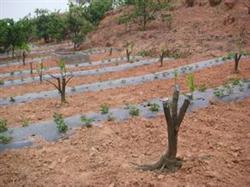Summer pruning technique of navel orange

Summer pruning of navel orange has two functions: 1. Renew local branches and improve the distribution of tree nutrients. The growth potential and fruiting ability of citrus shoots changed with the increase of branch grades. The higher the branch order is, the weaker the secondary shoot is, and finally there is almost no ability to send the secondary shoot. In other words, the parts with lower branching levels naturally produce regenerated branches. According to the natural law of citrus growth, short pruning is mainly carried out to renew the weak branches around the crown and promote the reserve branches so as to improve the fruiting ability. 2. Increase the proportion of fruiting mother branches of secondary shoot and autumn shoot and increase yield. The second shoot of navel orange in autumn, such as spring and autumn shoot, summer and autumn shoot, and even spring, summer and autumn shoot, has two times more carbohydrates and stronger physiological activity than other annual shoots, so it can accumulate more organic nutrients and become a good fruiting mother branch in the following year. Summer shearing can promote multi-quality autumn shoots, which is beneficial to increase yield. Combined with winter retraction, the ventilation and light transmission conditions can be improved and the full fruit period can be prolonged. 1. Techniques for summer pruning of navel oranges: 1.1. The suitable time for summer pruning is generally larger trees, more fruits, and weaker trees. Orange orchards without irrigation conditions can be pruned in the first and middle of July to place autumn shoots. Strong trees and young trees can be pruned in early August and placed in summer shoots. 1.2. pruning objects: in the weak branch group, the navel orange can leave a branchlet or strong leaf short at the 0.6-1cm of the base branch of the branch group; the mother branch or deciduous branch of the deciduous flower or deciduous branch can be cut short in the appropriate position; the strong spring and summer shoot is cut short with 5 UV and 8 leaves; the extended branch of the main branch and secondary main branch should not let it bear fruit, erect single-apical fruit branch, with fruit for shoot, can be cut at the base of the fruit stalk. 1.3, the degree of pruning and the selection of cutting position. Summer shearing is carried out in the vigorous growth season, so it is not suitable for large sawing and heavy pruning. The degree of pruning is measured by the number of leaves removed, and strong leaves should be retained at the cut, especially when the branches are short, erect and sturdy, leave leaf branchlets at the cut, and then cut the branchlets short, so as not to get infected or dry up. 2. Management after summer shearing 2.1 strengthen fertilizer and water management. High-quality autumn fertilizer should be applied half a month before summer cutting, and the amount of fertilizer should account for 40% of the total fertilizer for the whole year. Fertilization combined with irrigation to promote autumn shoots. 2.2 wipe the buds and put them on the tip, and choose to pick the heart. The first bud under the cut is the first to germinate and should be erased in time. The first, second and third buds and the new buds of the whole tree can sprout generally, and when there are enough buds, they can stop wiping buds. If there is a clumping phenomenon, when the new shoots grow 10-15cm, the strong shoots with oblique posture will be evenly distributed, and 3 strong shoots with oblique posture can be removed. 2.3 the focus of pest control and shoot protection is the control of leaf miner. But after putting the shoot, when the length of the new shoot reaches about 3mm, spray 500x insecticidal double + 1500mm 2000 times latent dragon, once every 5-7 days, spray 2-3 times in succession. After the leaf development of new shoots, attention should be paid to the prevention and control of red spiders to ensure that new shoots do not like harm. When spraying pesticides, urea and potassium dihydrogen phosphate can be added for foliar topdressing to promote the green of new leaves.
- Prev

How to prevent and cure the three major diseases of navel orange
The fruit characters of navel orange grafted on adult mandarin trees were normal in the first two years, and then the bad characters of variety degradation appeared year by year: shorter shoots, smaller leaf shape, lighter leaf color and weaker tree potential. Fruit rate decreased, fruit shape became smaller, pericarp dim and dull, flavor became lighter and fruit quality decreased. In production practice.
- Next

Cultivation Techniques of Navel Orange Variety--Late Navel Orange
1. Adaptability and suitable cultivation area: wide adaptability, suitable for planting navel orange in China can be planted in the area, but after planting there is a phenomenon of low or unstable yield. 2. Cultivation technology points and precautions: (1) suitable rootstock seedlings, reasonable planting: in acid, neutral soil, available rootstock; but in alkaline, appropriate harvest...
Related
- Moge, come on! The staff of the peasant association in the producing area of cantaloupe were frightened when the crowd gathered.
- Causes and Solutions of low Fruit setting rate of Apple
- Symptoms and control measures of passion fruit virus disease
- Fruit growing lesson: how do apple orchards keep high yields?
- Can you build orchards in the mountains? What are the pros and cons?
- How to manage the coloring period of Crisson grape?
- This paper introduces the processing technology of two kinds of fig products.
- How much is a month for retired teachers in rural areas by 2020?
- How can strawberry planting increase sugar content? We should pay attention to management in many aspects.
- What are the cultivation techniques on how to improve the yield of golden fruit?

